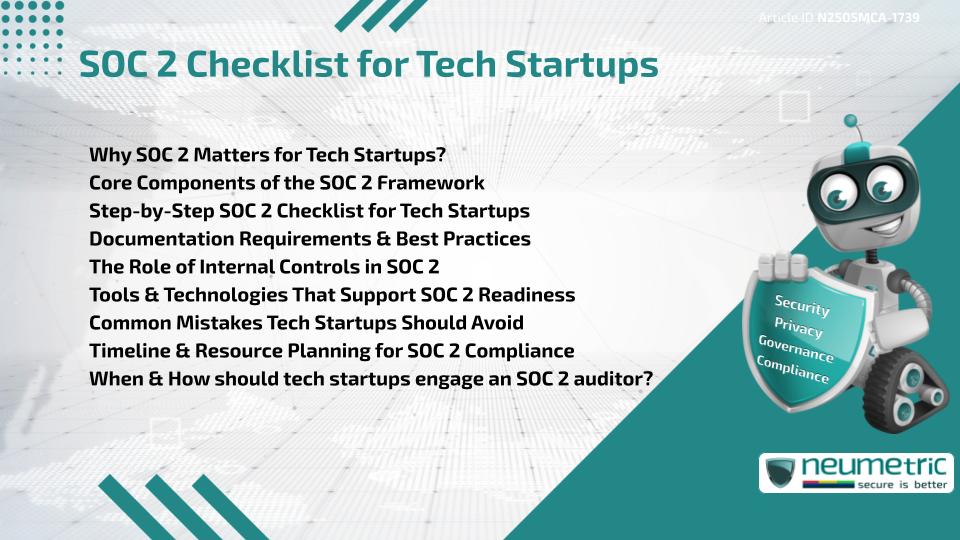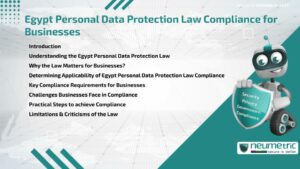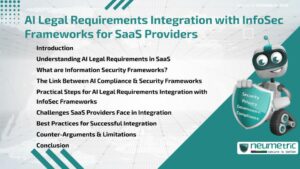Table of Contents
ToggleIntroduction
For tech startups entering competitive markets, building Customer Trust is as important as developing innovative products. One way to signal your commitment to Data Security & operational integrity is by aligning with the Service Organisation Control 2 [SOC 2] Framework. Designed specifically for service providers handling Sensitive Data, SOC 2 is more than a certification—it’s a systematic approach to earning credibility.
This article offers a practical SOC 2 checklist for tech startups that want to streamline their Compliance efforts, avoid common missteps & confidently work toward Audit readiness.
Why SOC 2 Matters for Tech Startups?
SOC 2 Compliance is essential for startups managing Customer Data, especially those in SaaS, cloud or enterprise service sectors. Earning SOC 2 Compliance helps build Client trust in your security practices & also strengthens your internal operations.
SOC 2 is made up of five main Trust Services Criteria: Security, Availability, Processing Integrity, Confidentiality & Privacy. Security is the required criterion for most startups, while the remaining ones are selected based on what aligns best with their business needs.
Without a clear SOC 2 checklist for tech startups, it’s easy to get lost in documentation or overlook essential controls.
Core Components of the SOC 2 Framework
It’s important to understand the key elements of SOC 2 before starting the checklist process:
- Control Environment – Your startup’s Policies, culture & management tone regarding security.
- Risk Assessment – Identification of potential security Threats.
- Control Activities – Technical & procedural safeguards.
- Information & Communication – Refers to the secure exchange of data within your team & across the Organisation.
- Monitoring Activities – Ongoing evaluation of control effectiveness.
Step-by-Step SOC 2 Checklist for Tech Startups
A comprehensive SOC 2 checklist for tech startups includes the following steps:
1. Define your Scope
Define which systems, services & data will be included inside the SOC 2 Audit. The narrower the scope, the simpler the process.
2. Choose your Criteria
Startups typically begin with Security. Decide if you also need to include Availability, Confidentiality or other criteria based on Customer demands.
3. Perform a Gap Assessment
Assess your current Policies & practices against SOC 2 standards. Use publicly available checklists to identify any gaps.
4. Establish Policies & Controls
Create Security Policies related to Data Encryption, access management, Incident Response & Employee onboarding/offboarding.
5. Implement Technical Safeguards
Use tools like endpoint monitoring, firewalls & secure authentication protocols. Ensure backups are automated & tested regularly.
6. Train your Team
Security awareness training is not optional. Your Audit depends on whether your staff knows & follows internal Policies.
7. Document Everything
Keep updated records of all security procedures, change logs & access requests. This documentation is essential for the auditor.
8. Conduct Internal Audits
Simulate the Audit experience by running internal checks. Consider using a readiness assessment tool to support your SOC 2 preparation.
9. Engage a Certified Auditor
Once ready, engage a CPA firm with solid experience in conducting SOC 2 audits. Clarify whether you’re going for a Type I (design of controls) or Type II (design + operating effectiveness) report.
Documentation Requirements & Best Practices
The quality of your documentation can determine how smoothly your SOC 2 Audit proceeds. Startups should maintain:
- Access Control logs
- Incident Response procedures
- Risk Assessment reports
- Security training records
- Change management documentation
Organise these in a centralised repository with version history & access permissions.
The Role of Internal Controls in SOC 2
Internal controls are the backbone of SOC 2. These are the measures your startup takes to ensure secure operations—ranging from hiring background checks to firewalls & multi-factor authentication.
Effective internal controls reduce the Likelihood of breaches & demonstrate maturity to auditors & customers. A strong SOC 2 checklist for tech startups always includes periodic evaluation of these controls.
Tools & Technologies That Support SOC 2 Readiness
Using the appropriate tools can help reduce both time & effort during the Compliance process. Commonly used platforms include:
- Automate policy management to streamline Compliance tasks.
- Control access with identity management tools for secure authentication.
- Enable Audit logging to track User actions & system events.
These tools automate many of the control activities outlined in your SOC 2 checklist for tech startups, helping you focus on core business tasks.
Common Mistakes Tech Startups Should Avoid
Certain mistakes can delay or disrupt the path to SOC 2 Compliance:
- Over-scoping the Audit
- Relying solely on technical controls
- Ignoring human errors & insider Risks
- Failing to update Policies regularly
- Not performing readiness assessments
Being aware of these can help avoid unnecessary delays or rework.
Timeline & Resource Planning for SOC 2 Compliance
Tech startups typically need around three (3) to six (6) months to get ready for SOC 2 Compliance. The exact timeline depends on:
- Current maturity of controls
- Size of the Audit scope
- Availability of internal resources
- Audit firm schedule
Assign a Compliance owner, usually a CTO or operations lead, to manage timelines, track progress & liaise with auditors.
When & How should tech startups engage an SOC 2 auditor?
Engage an auditor only after the internal controls are fully implemented & tested. Look for firms that:
- Specialise in startups
- Offer fixed-fee pricing
- Are licensed to issue SOC 2 reports
Takeaways
- A clear SOC 2 checklist helps startups streamline their Compliance efforts.
- Focus first on defining scope & performing a gap assessment.
- Leverage automation tools & maintain thorough documentation.
- Avoid common mistakes like over-scoping or neglecting training.
- It’s best to bring in an auditor after completing a thorough readiness assessment.
FAQ
What should tech startups do first when starting a SOC 2 Compliance checklist?
The first step is defining your Audit scope, which includes identifying which systems, services & data types will be evaluated.
How long does it take for a startup to complete SOC 2 Compliance?
The process usually takes about three (3) to six (6) months, depending on how developed your internal controls are & the resources available to support the effort.
Can a startup do SOC 2 without external help?
Although startups can manage the process on their own, many find it helpful to use consultants or automation tools to maintain progress & prepare.
How does SOC 2 Type I differ from SOC 2 Type II?
Type I reviews how your controls are designed at a specific moment, whereas Type II assesses both the design & how well those controls operate over a set period.
Why is SOC 2 important for startups offering SaaS?
SOC 2 builds trust with enterprise clients by proving your startup handles data securely & operates under strict internal controls.
Do all five Trust Services Criteria apply to startups?
No. Startups must include Security but can choose others like Availability or Confidentiality depending on Client expectations.
Are there free resources to help with SOC 2 preparation?
How often should internal audits be done?
Quarterly internal audits are ideal for startups, especially in the months leading up to an external SOC 2 assessment.
Need help?
Neumetric provides organisations the necessary help to achieve their Cybersecurity, Compliance, Governance, Privacy, Certifications & Pentesting goals.
Organisations & Businesses, specifically those which provide SaaS & AI Solutions, usually need a Cybersecurity Partner for meeting & maintaining the ongoing Security & Privacy needs & requirements of their Clients & Customers.
SOC 2, ISO 27001, ISO 42001, NIST, HIPAA, HECVAT, EU GDPR are some of the Frameworks that are served by Fusion – a centralised, automated, AI-enabled SaaS Solution created & managed by Neumetric.
Reach out to us!





